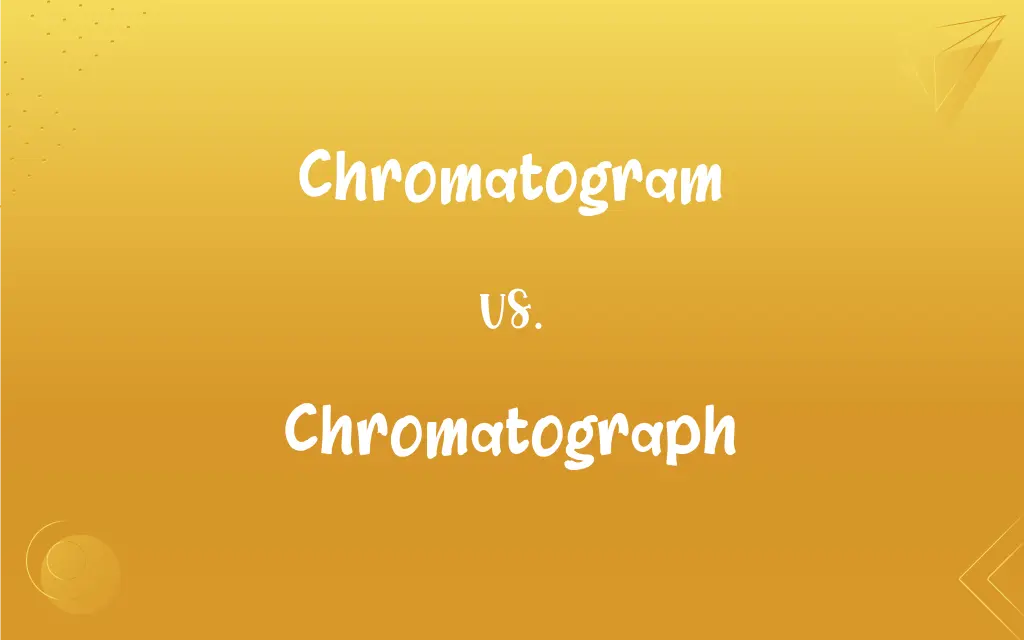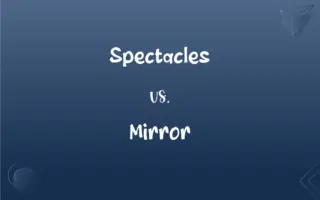Chromatogram vs. Chromatograph: What's the Difference?
Edited by Aimie Carlson || By Janet White || Updated on October 12, 2023
A chromatogram is the visual output or pattern produced, while a chromatograph is the instrument or apparatus used for chromatography.

Key Differences
The terms "Chromatogram" and "Chromatograph" might seem alike, but they denote different aspects within the realm of chromatography. A chromatogram refers to the visual representation, often on paper or a screen, showcasing the result of the separation process of a sample.
Conversely, the term "Chromatograph" is reserved for the actual equipment or instrument utilized in the process of chromatography. This apparatus facilitates the separation of mixtures into their individual components based on their interaction with a stationary phase.
In simpler terms, one can think of the relationship between a Chromatogram and a Chromatograph similarly to the relationship between a printout and a printer. The chromatogram is the "printout" or output, while the chromatograph is the "printer" or tool.
To delve a bit deeper, a chromatogram showcases peaks and valleys. These peaks correspond to different components of a sample, allowing scientists to identify and quantify them. The chromatograph, on the other hand, is equipped with detectors, columns, and other parts to perform the separation and produce a chromatogram.
Conclusively, while both terms are intrinsically linked and vital to the science of chromatography, the chromatogram is the result or outcome, and the chromatograph is the mechanism facilitating this result.
ADVERTISEMENT
Comparison Chart
Primary Function
Visual representation of separated sample
Equipment used for chromatographic separation
Nature
Output or result
Instrument or apparatus
Grammatical Usage
Often a noun describing a visual pattern
Primarily a noun describing a piece of equipment
Related Field
Analytical chemistry
Analytical chemistry
Example Phrase
"The chromatogram displayed multiple peaks."
"The lab was equipped with a state-of-the-art chromatograph."
ADVERTISEMENT
Chromatogram and Chromatograph Definitions
Chromatogram
A visual output showing the result of chromatographic separation.
The scientist analyzed the peaks on the chromatogram.
Chromatograph
Equipment used in analytical chemistry to separate and analyze compounds.
The research facility was equipped with multiple chromatographs for various experiments.
Chromatogram
A pattern formed by colors or substances separated using chromatography.
The colorful chromatogram was a result of separating pigments from leaves.
Chromatograph
An instrument used for separating mixtures in chromatography.
The lab technician operated the chromatograph to analyze the sample.
Chromatogram
A graphical representation used to identify and quantify the components of a mixture.
By examining the chromatogram, she could determine the concentration of each substance.
Chromatograph
A device that facilitates the separation of substances based on their interaction with a stationary phase.
The new chromatograph was more efficient and provided faster results.
Chromatogram
A record, typically on paper or digitally, displaying the varying amounts of separated components.
The chromatogram indicated the presence of multiple compounds.
Chromatograph
An apparatus used for producing chromatograms.
Using the chromatograph, he could separate even the most complex mixtures.
Chromatogram
A plot where the response from a detector is on the y-axis, and time or volume is on the x-axis.
The height of peaks in the chromatogram corresponds to the amount of each solute.
Chromatograph
A tool that combines a mobile phase and a stationary phase to separate substances.
The chromatograph in the chemistry lab was regularly calibrated to ensure accuracy.
Chromatogram
The pattern of separated substances obtained by chromatography.
Chromatograph
An instrument that produces a chromatogram.
Chromatogram
(analytical chemistry) The visual output from a chromatograph. Usually a graphical display or histogram.
Chromatograph
To separate and analyze by chromatography.
Chromatogram
The paper strip, column, gel, or TLC plate on which subsances have been separated by a process of chromatography{2}.
Chromatograph
(analytical chemistry) A machine that performs chromatography by gas or liquid separation.
Chromatogram
The record of the results of a process of chromatography{2}, produced by an instrument which measures some property related to the concentration of substances over the course of a chromatographic process. The record may be printed, for example, on a piece of paper, showing the concentration of some substance as a function of time or volume; or it may be retained in a computer and displayed on a video display terminal.
Chromatograph
To analyze or separate mixtures using chromatography
Chromatogram
The recording (column or paper strip) on which the constituents of a mixture are adsorbed in chromatography
Chromatograph
A piece of equipment used to perform chromatography{2}.
FAQs
What is a chromatogram?
A chromatogram is the visual output or pattern produced from chromatographic separation.
Can you use "chromatogram" and "chromatograph" interchangeably?
No, they refer to different things: one to the result (chromatogram) and the other to the instrument (chromatograph).
How do you read a chromatogram?
A chromatogram displays peaks that correspond to different components of a sample, allowing identification and quantification.
Does a chromatograph always produce a visible chromatogram?
Not necessarily. The output might be digital or visual, depending on the detector used.
And a chromatograph?
A chromatograph is the instrument or apparatus used to perform chromatography and produce a chromatogram.
Can one chromatograph produce multiple chromatograms?
Absolutely. Each analysis or sample run on a chromatograph produces a unique chromatogram.
Why is a chromatogram important?
It provides valuable data about the components and concentrations of substances in a mixture.
Do all chromatograms look the same?
No, the appearance and pattern of a chromatogram will change based on the sample and the method used.
How long does it take for a chromatograph to produce a chromatogram?
It varies based on the sample and the chromatography method used. Some analyses are quick, while others can take hours.
Is the use of a chromatograph limited to specific fields?
While commonly used in chemistry, chromatographs are also used in biology, environmental science, and other disciplines.
Is a chromatogram always in color?
No, the appearance of a chromatogram depends on the detection method. Some show as colored bands, while others appear as peaks on a graph.
What's the primary purpose of a chromatograph?
It's used to separate mixtures into individual components based on their interactions with the stationary and mobile phases.
How are chromatograms stored?
They can be stored digitally, printed on paper, or sometimes recorded on specialized sheets.
What can cause errors in a chromatogram?
Factors like instrument calibration, sample contamination, and inconsistent flow rates can affect the chromatogram.
Do all labs have the same type of chromatograph?
No, labs choose chromatographs based on their specific research needs, sample types, and chromatography techniques.
Are there different types of chromatographs?
Yes, depending on the technique—like gas chromatography or liquid chromatography—the design and function of the chromatograph may vary.
Can any chromatograph produce a chromatogram of any sample?
No, the sample and the type of chromatography technique must be compatible for accurate results.
Can I interpret a chromatogram without the chromatograph?
Yes, once produced, a chromatogram can be analyzed independently from the instrument.
What's the relationship between a chromatograph's detector and the chromatogram?
The detector captures the response of separated components, which is then represented on the chromatogram.
Can I refer to a chromatograph as a "separator"?
While it does separate components, the standard term is "chromatograph" to avoid confusion with other types of equipment.
About Author
Written by
Janet WhiteJanet White has been an esteemed writer and blogger for Difference Wiki. Holding a Master's degree in Science and Medical Journalism from the prestigious Boston University, she has consistently demonstrated her expertise and passion for her field. When she's not immersed in her work, Janet relishes her time exercising, delving into a good book, and cherishing moments with friends and family.
Edited by
Aimie CarlsonAimie Carlson, holding a master's degree in English literature, is a fervent English language enthusiast. She lends her writing talents to Difference Wiki, a prominent website that specializes in comparisons, offering readers insightful analyses that both captivate and inform.































































